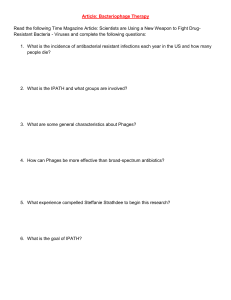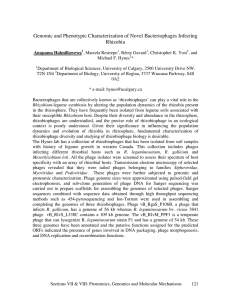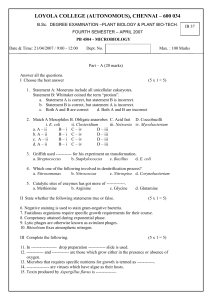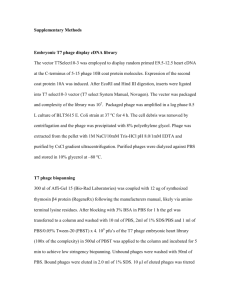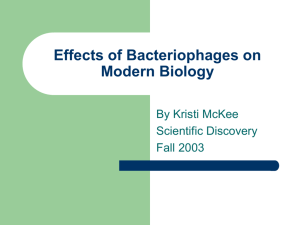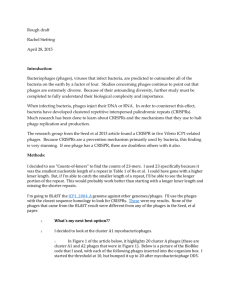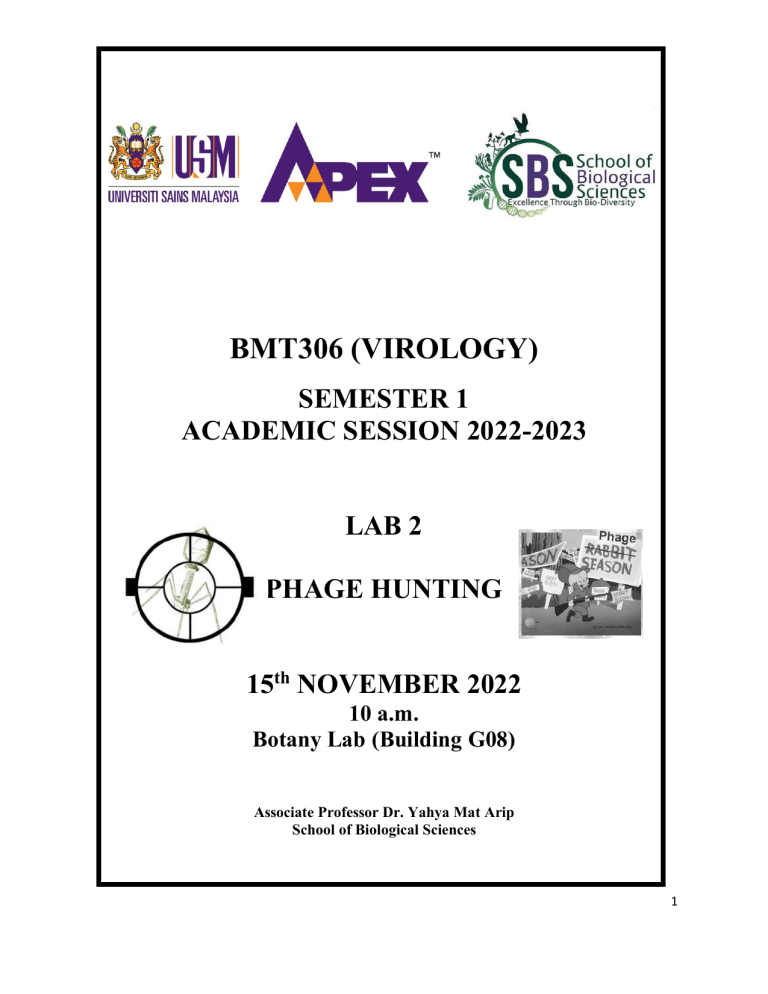
BMT306 (VIROLOGY) SEMESTER 1 ACADEMIC SESSION 2022-2023 LAB 2 PHAGE HUNTING 15th NOVEMBER 2022 10 a.m. Botany Lab (Building G08) Associate Professor Dr. Yahya Mat Arip School of Biological Sciences 1 INTRODUCTION One of the members in the microbial communities is bacteriophage (from 'bacteria' and Greek phagein "to eat") or phage for short is any one of a number of viruses that infect bacteria. Phages are among the most common biological entities on earth and are found in all habitats in the world where bacteria and archaea proliferate. They are estimated to be the most widely distributed biological entity in the biosphere, with an estimated phage population of greater than 1031 or approximately 10 million per cubic centimeter of any environmental niche where bacteria or archaea reside [1]. One of the densest natural sources for phages and other viruses is sea water, where up to 9×108 phages per milliliter have been found in microbial mats at the surface [2] . In the oceans, phages exert significant control on marine bacterial and phytoplankton communities, with respect to both biological production and species composition, influencing the pathways of matter and energy transfer in these systems. Up to 70% of marine bacteria may be infected by phages. On average there would be 107 phages per every gram of soil or feces [3] . On a global scale, it was estimated that ~1025 phages initiate an infection every second. Therefore, it is not surprising that phages play major roles in the ecological balance of microbial life. Out of the estimation of more than 1031 phages, only approximately 5100 have been identified and reported towards the end of last century [4] . This means that there are so many more phages waiting to be discovered. Out of 5100 discovered phages, 4950 are tailed phages which are composed of an icosahedral head and a tail. All those tailed phages have doublestranded DNA (dsDNA) as genome and are lytic phages. Currently, the International Committee on Taxonomy of Viruses (ICTV) classifies these phages into one Order (Caudovirales), 13 Families and 34 Genera plus one unassigned Genus (Salterprovirus). Out of 13 families, three families are doubled-stranded DNA (dsDNA) tailed phages (Myoviridae - contractile tail, Siphoviridae - long noncontractile tail) and Podoviridae – extremely short tail). The other ten families are cubic, filamentous, or pleomorphic phages with dsDNA, single-stranded DNA (ssDNA), double-stranded RNA (dsRNA), or single-stranded RNA (ssRNA) genome. 2 In this laboratory practical, you will have the opportunity to isolate phages from an environmental sample, i.e, raw sewage. You should not have problems isolating phages since phages could be found almost everywhere. You will use different bacteria hosts as a mean to isolate different phages. Good Luck! OBJECTIVES (i) To isolate bacteriophages from raw sewage sample. (ii) To identify isolated phages based on phage-host specific interaction. MATERIALS: 1. ½ LB agar plate Bacto-tryptone = 5g/L Yeast extract = 2.5g/L Sodium Chloride (NaCl) = 5g/L Agar = 15g/L 2. Top agar Bacto-tryptone = 20g/L Yeast extract = 10g/L Sodium Chloride (NaCl) = 20g/L Agar = 7.5g/L 3. LB media Bacto-tryptone = 10g/L Yeast extract = 5g/L Sodium Chloride (NaCl) = 10g/L 4. Host cells: different bacteria will be provided as hosts for phage isolation. 5. Others: Raw sewage, filter paper, syringe, bacteria filter (0.2 m), eppendorf tube, pipette, pasture pipette, funnel, and micro centrifuge. 3 PROCEDURE: NOTE: It is important to use good ASEPTIC technique throughout these procedures. Reagents, tubes, etc. have been sterilized. Also, be sure to follow SAFETY procedures for working with bacteria: No eating or drinking in lab; keep hands away from face; wash hands before leaving lab; disinfect bench surface before and after working; discard bacteria waste in designated containers for sterilizing prior to disposal; clean up any spills using disinfectant. 1. Obtain 10 mL of raw sewage. 2. Filter the raw sewage using the filter paper provided to remove coarse material, as shown in the figure below. 3. Transfer 1 mL of the filtrate into four clean eppendorf tubes and centrifuge at full speed for five minutes. This is to remove fine particles that might passed though the filter paper. 4. Obtain a syringe and a bacterial filter (0.2 m) Bacteria filter Syringe 4 5. Draw the filtrate into the syringe, as shown in the figure (a) below. Then, connect the bacteria filter to the syringe, as in figure (b). (a) (b) 6. Then, force the filtrate through the filter by depressing the plunger, as shown figure below. Make sure there is no air trap or bubbles between the filtrate inside the syringe and the filter. If there is air trap or bubbles, turn the syringe upside down and push the plunger to remove the air or bubbles. Collect the filtrate into a clean Eppendorf tubes. 7. Mix 0.1 mL of host cells with one drop, five drops and 0.1 mL of your filtrate onto ½ LB agar plate, respectively. Do not forget your control plate: 0.1 mL of host cells mix with 0.1 mL of LB media. 8. Add 3 mL of top agar onto the plate and spread evenly. 9. Let the top agar solidify for at least five minutes. Invert the plates and incubate them overnight at 37C. 10. Next morning, check for plaque formation and differences in plaque morphology (size, shape, and appearance, etc.) produced by the different phages infecting various host cells. 11. Take a photo of the plates and record your observations. 5 QUESTIONS 1. How many different kinds of phages could you possibly isolate from the given sample? Justify your answer. 2. One group of students got plaques on their plates. However, some of the plaques were turbid and some were clear. Discuss the possible explanations for this observation. 3. Result from another group of students showed plates with lawn of bacteria growth and not a single plaque formed. Did this mean that their samples did not contain any phages? Justify your answer. 4. Based on their theoretical knowledge that phages are ubiquitous, discuss how they would proceed to show the presence of phages in the sample. 5. Discuss: i. Why phages specific to their host cells? ii. Why two of the same phages could not share the same host cell? 6. Discuss other potential phage applications beside phage therapy and phage typing. 7. Differentiate between somatic phage and F-phage. 6 REFERENCES [1] Ye. M., Sun, M., Huang, D., Zhang, Z., Zhang, H., Zhang, S., Hu, F., Jiang, X., and Jiao, W. (2019). A review of bacteriophage therapy for pathogenic bacteria inactivation in the soil environment. Environment International. 129: 488–496489. [2] Brussaard, C. P., Baudoux, A, and Rodríguez-Valera F (2016). Stal, L. J. and Cretoiu, M. S. (eds.). Marine Viruses. In book: The Marine Microbiome. Springer International Publishing. pp. 155–183. Doi:10.1007/978-3-319-33000-6_5 [3] Armon, R. (2011). Witzany, G (ed.). Soil Bacteria and Bacteriophages. In book: Biocommunication in Soil Microorganisms. Springer-Verlag Berlin Heidelberg. pp. 67-112. Doi: 10.1007/978-3-642-14512-4_3 [4] Adriaenssens, E. M. and Brister, J. R. (2017). How to Name and Classify Your Phage: An Informal Guide. Viruses. 9, 70; Doi:10.3390/v9040070 7
